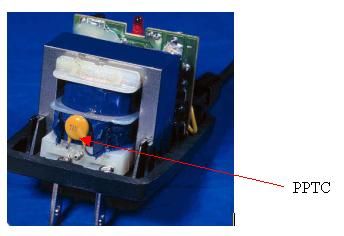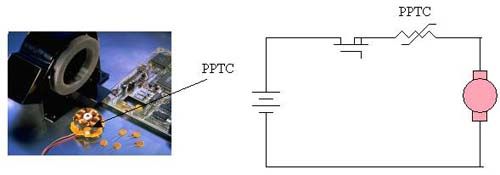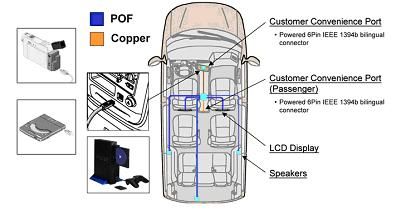Application of PPTC protection device technology in automotive electronics
PPTC device technology has been widely used in the design of overcurrent and overheating circuit protection for portable appliances, mobile phones, computers and remote communication equipment. The new standard on passive components introduced by the Automotive Electronics Technical Committee has promoted the application of polymer positive temperature coefficient device (PPTC) circuit protection technology in the automotive industry.
The new car design is mainly aimed at electronic circuits and mobile accessories, such as power windows, power seats, sunroof control and telematics devices, aimed at reducing costs and improving reliability and functionality.
The motor drive and control devices are subject to certain harsh working environments and require continuous and reliable operation. On-site failures are unavoidable. Choosing the correct circuit protection strategy will help ensure product reliability and minimize the maintenance costs of manufacturers and customers. The PolySwitch â„¢ polymer positive temperature coefficient (PPTC) resettable circuit protection device provided by the Raychem circuit protection department is used to provide a more stable and reliable product. It can protect some common faults in the motor drive and control system.
PolySwitch PTC devices are available in lead, shaft, chip, disk, and surface mount types. The small size of the polymer positive temperature coefficient device helps to save valuable circuit board space. Because of its self-resetting function, it can be placed in a location that is not accessible to users, which is different from traditional fuses that need to be placed in a place where users can easily replace it. Compared with the location for replacement, there are obvious differences. Since the polymer positive temperature coefficient device is a solid-state device, it can also withstand mechanical shock and vibration, and can provide reliable circuit protection for various applications.
Power protection
PolySwitch devices have been used for overload and short circuit protection at the DC output of power supplies. After developing the LVR series products, PolySwitch devices can now be used in the AC main circuit at the power input. This product places AC line transformers and other line-side equipment within the protection range of the PolySwitch device product family. These products can protect the power supply when the neutral line is accidentally disconnected or the AC line voltage is used at the 24 VAC input. The LVR device is suitable for power supply systems, and its maximum input current can be as high as 400 mA at 120VAC and 240VAC. The power supply system with higher current can place the PolySwitch device in the output circuit of the secondary side to protect the power failure caused by the overcurrent state.

Protection of RXE input / output interface
Many drives and control devices are equipped with communication and data interfaces for information transmission between various system components. The wiring of these interfaces is sometimes laid side by side with AC or DC power cables. These wiring harnesses may be short-circuited due to normal wear and tear, accidents, incorrect installation wiring, or misoperation on the central distribution box. If the power cable and the communication wire are short-circuited, the PolySwitch device can protect any system connected to this short-circuit line from damage to the communication interface. In some cases, this phenomenon may affect many systems. The role of PolySwitch devices in protecting the interface can significantly reduce the downtime and repair costs of common equipment failures.

Overheating protection
The PolySwitch device can respond to the temperature rise caused by the heat from the outside and the heat generated by the internal current, and can establish a thermal connection with the high-voltage equipment to provide overheat protection for the high-voltage equipment. Establishing this thermal connection can be achieved by arranging these devices in contact with or close to high-voltage equipment.
The contact method enables PolySwitch devices to easily make physical contact with the device, thereby improving the protection effect. Transformers are a good example of this type of equipment. PolySwitch devices can be tied to external coils or enclosures to establish thermal contact. The PolySwitch device can be incorporated into the circuit at design time, so that it has the ability to send a warning to the controller when the transformer is overheated, and the system stops immediately.
The close-range method is suitable for the protection of power semiconductor components, and the best effect is when the small surface mount PolySwitch device and the power device are on the same copper backplane. This is a low-cost thermal contact method that enables the PolySwitch device to operate when the temperature exceeds its operating point, and at the same time informs the power device that it should stop running when it is overheated.
In this kind of application, there will be a certain degree of thermal delay, so this protection scheme cannot protect high-current components and power supply devices where the components fail within milliseconds. However, for most overload conditions, this configuration can provide protection for power supply devices.

Motor stall protection
Moving machinery may be blocked or broken, and may cause the motor to stall. Continued power supply when the motor stalls will cause damage to the motor and / or damage to the drive. After connecting the PolySwitch device and the motor driver in series, the motor and the drive electronic circuit can be protected against system failure in the state of stall or excessive load. After the fault is cleared (and after the power is turned off), the system can resume normal operation without maintenance or replacement of parts. For many years, PolySwitch devices have been the most commonly used solutions to protect seats, windows and other motors in the automotive industry. In these applications, the use of PolySwitch devices requires consideration of the series resistance and the maximum holding current rating of the device. The maximum operating current at room temperature is 15A at 16V and 9A at 30V.

In these applications, when these systems cause external faults due to overcurrent or overheating conditions, PolySwitch devices can allow motor drive and controller systems to continue to operate. The advantage is that it provides a powerful and reliable product that can protect the system when other components fail.
PolySwitch device application in automotive IEEE 1394 network
In the automobile industry, the increasingly close relationship between family lifestyle and automobile is booming. By adopting the standardized global interface developed by the American Automobile Multimedia Interface Association (AMI-C), it can be easily connected to various consumer electronic devices and facilitate the rapid installation of these devices. The network called the IEEE 1394 serial bus in the consumer electronics industry is designed with the transmission of multimedia content in mind. This additional standard for the automotive industry is called IDB-1394 and was formulated by the "1394 United Automotive Industry Group."
IDB-1394 is designed for high-speed multimedia applications, that is, transmitting large amounts of information quickly in the car. This open standard allows portable electronic devices to connect and interact with the vehicle network, establishing a communication channel for both.
The power supply interface needs to provide overcurrent protection, and the power supply standard used by the existing automotive system was promulgated many years ago. Since the user convenience port (CCP) is used to transmit signals and power, it must be protected to prevent short circuits or damage to downstream equipment due to various failures, such as poorly connected cables or connectors inserted into the product. This situation may happen frequently, so the short circuit protection of the central control panel must be effective and reliable.
Application Overview
As shown in the figure, the architecture of the vehicle network can be divided into an embedded network and a user convenience port (CCP). The current technical specifications define the embedded plastic optical fiber (POF) vehicle network as a specification similar to the existing MOST (Media Oriented System Transmission) technology. However, the former has a more stable architecture, can provide higher data transmission rates, and is easier to implement. This network can connect various electronic devices, such as DVD players, video display screens, navigation systems, radio receiving equipment, communication equipment, such as wireless phones or emergency automatic telecommunications and information processing technology terminology, and other multimedia applications.

This video-audio network includes a user convenience port (CCP) for passengers to connect their CD players, game consoles, and other devices and peripherals that use the 1394 bus to the network. The cables are commonly used in homes and cars. .
Circuit protection requirements
In a hot-swap automotive environment, because customers often have to connect and disconnect various peripherals on the power interface, there is a clear danger of short-circuit damage. The power supply interface is required to have the function of overcurrent protection, and the existing power supply standard applied in the current automotive system was formulated many years ago. Because the user-friendly interface is used to transmit signals and power, it must be protected to prevent short circuits or damage to downstream equipment due to various faults, such as poorly connected cables or connectors inserted into the interface. This situation may occur frequently, so the short-circuit protection of the central control panel must be effective and reliable, and it is best to be able to reset.
Current limiting can be achieved by using resistors, fuses, switches, or polymer positive temperature coefficient (PPTC) devices. At present, the resistance protection scheme is rarely used because it will generate an excessive voltage drop under normal current conditions. It is possible to use a one-time fuse solution, but this protection is easily damaged and must be replaced after a failure. The limitation of the bimetallic switch is that it has been turned on repeatedly, and may cause contact fusion failure. In many automotive applications, the best protection scheme is a polymer positive temperature coefficient (PPTC) device, which exhibits low impedance in normal operation and high impedance in the event of a fault.
PolySwitch polymer positive temperature coefficient devices are widely used in IEEE 1394 applications and often provide resettable circuit protection for computers, peripherals, and portable electronic equipment. In automotive multimedia applications, this device is often used to provide circuit protection for the input and output interfaces of GPS positioning equipment, CD changers, audio and other electronic peripherals.
Protect GPS (Global Positioning System) components, CD changers, stereos and other electronic peripherals connected to the automotive network:

Above: PolySwitch device can help circuit designers meet the safety requirements of circuit design, and provide circuit protection for power interfaces, remote electrical communication equipment and portable devices connected to the vehicle network
The PPTC device is similar to the traditional fuse in that it can limit the dangerous large current under the fault generation and continuous state; the difference is that after the fault is eliminated and / or the circuit power is disconnected, the PPTC device can automatically Reset. Another advantage is that the polymer positive temperature coefficient devices are relatively small, can be directly mounted on the circuit board, and can be installed in electronic modules, junction boxes and power distribution center components.
The use of in-vehicle products with general electronics industry standards can help customers upgrade their cars with newly launched products. The universal bus also helps car manufacturers to solve the problem of outdated technology caused by technological progress and constantly leading the cycle of automotive design cycles. In a hot-swap automotive environment, because customers often have to connect and disconnect various peripherals on the power interface, there is a clear danger of short-circuit damage. The polymer positive temperature coefficient device provides an effective overcurrent protection scheme for this problem. This resettable circuit protection device also helps manufacturers produce safe and reliable products to meet the requirements of regulatory agencies, and reduce product warranty and repair costs.
The IDB-1394 standard interface allows users to use hot-swappable devices, and overcurrent protection for power interfaces and portable devices on multimedia networks must be reliable and economical. PolySwitch series devices have the characteristics of low impedance, fast breaking response time, small size and resettable function, which help circuit designers design safe and reliable products to meet the requirements of regulatory agencies and reduce warranty costs.
The advantages of PolySwitch products also include manufacturing features that are compatible with large-scale electronic assembly technology, and the range of products available is very wide, providing greater flexibility in design.
Custom Made Drone, Custom Design Drone,DIY Drone
Custom Made Drone, Custom Design Drone,DIY Drone
shenzhen GC Electronics Co.,Ltd. , https://www.jmrdrone.com
